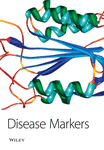Receiver Operating Characteristic (ROC) to Determine Cut-Off Points of Biomarkers in Lung Cancer Patients
Abstract
The role of biomarkers in disease prognosis continues to be an important investigation in many cancer studies. In order for these biomarkers to have practical application in clinical decision making regarding patient treatment and follow-up, it is common to dichotomize patients into those with low vs. high expression levels. In this study, receiver operating characteristic (ROC) curves, area under the curve (AUC) of the ROC, sensitivity, specificity, as well as likelihood ratios were calculated to determine levels of growth factor biomarkers that best differentiate lung cancer cases versus control subjects. Selected cut-off points for p185erbB-2 and EGFR membrane appear to have good discriminating power to differentiate control tissues versus uninvolved tissues from patients with lung cancer (AUC = 89% and 90%, respectively); while AUC increased to at least 90% for selected cut-off points for p185erbB-2 membrane, EGFR membrane, and FASE when comparing between control versus carcinoma tissues from lung cancer cases. Using data from control subjects compared to patients with lung cancer, we presented a simple and intuitive approach to determine dichotomized levels of biomarkers and validated the value of these biomarkers as surrogate endpoints for cancer outcome.




